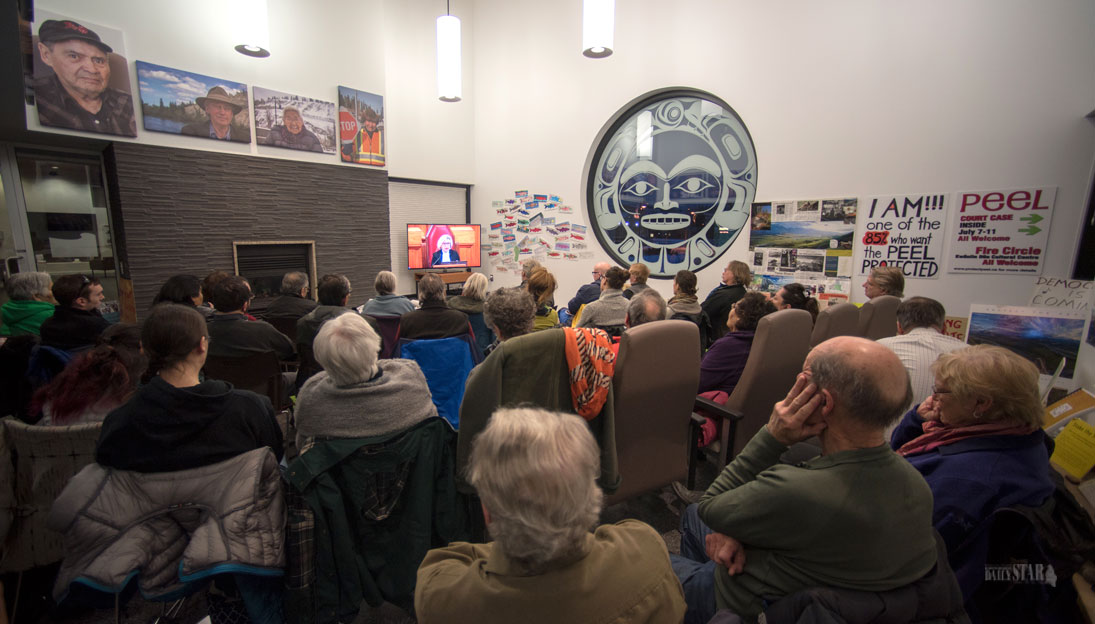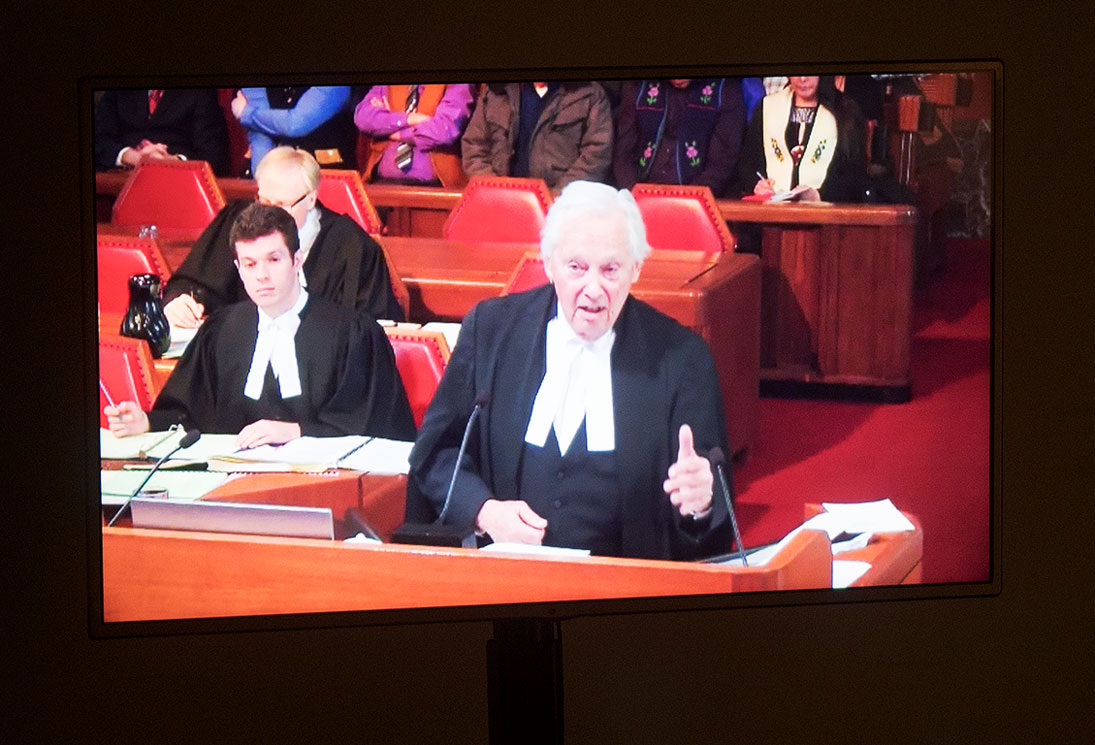
Photo by Vince Fedoroff
STRONG INTEREST – There were two rooms available at the Kwanlin Dun Cultural Centre this morning for viewing the proceedings in the Supreme Court of Canada

Photo by Vince Fedoroff
STRONG INTEREST – There were two rooms available at the Kwanlin Dun Cultural Centre this morning for viewing the proceedings in the Supreme Court of Canada

Photo by Vince Fedoroff
MAKING HIS ARGUMENTS – Thomas Berger, representing First Nations and environmental groups, addresses the Supreme Court of Canada in Ottawa this morning on the future of the Yukon’s Peel watershed. This is how the veteran litigator and judge looked on the screen at the Kwanlin Dun Cultural Centre in Whitehorse.
The case of the Peel watershed is in the hands of the Supreme Court of Canada, following this morning’s hearing in the nation’s capital.
The case of the Peel watershed is in the hands of the Supreme Court of Canada, following this morning’s hearing in the nation’s capital.
The nine justices of the high court heard the primary submissions from Thomas Berger on behalf of the First Nations and environmental organizations and John Laskin representing the Yukon government.
They also heard brief interventions provided by lawyers representing the Council of Yukon First Nations (CYFN), the Gwich’in Tribal Council and the Attorney General of Canada.
For some 2 1/2 hours, the parties presented their positions while the judges posed pointed questions.
Attending the hearing was a delegation of some 30 from the Yukon. Some could be seen sitting in the public gallery behind the lawyers, including Chief Roberta Joseph of the Tr’ondëk Hwëch’in.
Statistics provided by the Supreme Court of Canada show the court in the last five years has taken an average of four to six months to issue its decisions.
While there is a large outstanding legal question regarding the land use planning process for the Peel River watershed, the Yukon’s new Liberal government has already promised to implement the land use plan recommended by the planning commission in 2011 and supported by the First Nations.
It calls for 80 per cent wilderness protection of the 68,000 square kilometres with very little provision for road or railway access.
The high court heard from the parties this morning and in their written submissions that its decision on the Peel will have a huge bearing on how to interpret commitments made in the Yukon land claim agreements for years to come.
The parties, including the Yukon government, agree the court case arises from the government’s failure to live up to its obligations during the land use planning process.
What should be done about it is the question before the high court.
The government supports the Court of Appeal decision that sends the parties back to the table at the point where the error was made, to a point where it could still modify or reject the recommendation for 80 per cent wilderness protection and restricted surface access.
The First Nations and environment groups, on the other hand, support the original decision by Justice Ron Veale of the Yukon Supreme Court.
Veale’s remedy for the government’s failure was to send the parties back to the planning process, but to a point much further along than indicated by the Court of Appeal.
Veale’s remedy would see the Yukon government having to accept the 80 per cent wilderness protection, and the restricted surface access.
The hearing was webcast live beginning at 6:30 a.m. Yukon time. A feed was provided at the Kwanlin Dün Cultural Centre, where about 60 onlookers gathered to watch.
There were also gatherings in Dawson City and Inuvik.
“I am very happy to see how things went,” Christina Macdonald of the Yukon Conservation Society said in an interview from Ottawa following the hearing.
She said it was emotional to sit in the courtroom with many who had flown across the country from the Yukon and Northwest Territories to be there.
“I actually teared up a couple of times.”
The delegation from the North was greeted this morning on the steps of the Supreme Court by about 50 representatives from the Kitigan Zibi Anishinabeg Band who welcomed them to the unceded territory of the Algonquin First Nation, Macdonald pointed out.
Band members also performed the water ceremony, as today is World Water Day.
Macdonald said the many questions posed by the nine justices were a sign they were engaged with the issue before them.
“I really appreciated the questions because it really reminded everyone about the people and the land who are at stake here,” she said.
She recalled a question from one of the judges regarding why the Yukon government was looking for a second chance to go back to the planning process when it was the government that failed to live up to its obligations in the first place.
Berger insisted the government should not be given a second chance.
It had its opportunity to comment on the commission’s recommendation for 80 per cent wilderness protection and severely restricted surface access, along with three other recommendations.
In fact, the renowned aboriginal rights lawyer pointed out, the government did make a full, written reply to three other recommendations by the commission.
But when it came to wilderness protection, it simply asked the commission to take another look at balance between protection and opportunities for development, without any indication about what it wanted to see specifically, Berger pointed out.
He said it was the same for recommendation about access.
The planning commission took the government’s response and acted on the three other recommendations but when it came to the government’s response to the recommendations on protection and access, there was nothing specific to go on.
To revisit the issues, the commission indicated at the time, would require going back to square one in a process that was already several years long.
Berger told the Supreme Court the government didn’t breach the agreement. Rather, it chose not to put forward a full and detailed reply to the issues of wilderness protection and access, and it had an opportunity to do, he said.
Allowing the government a second crack at it now would undermine the intent and integrity of the Yukon’s land claim agreements, Berger suggested.
He emphasized Yukon First Nations sacrificed a lot in signing those land claims agreements, but one of the tradeoffs was a guarantee they would be full partners in managing the territory’s resources, in such initiatives as land use planning.
“So the judgment of this court will determine the true meaning of chapter 11 and the way the process laid down ought properly be conducted,” Berger told the court.
Submissions by the CYFN and the Gwich’in Tribal Council also suggested that giving the Yukon government a second chance would undermine the land claim agreements.
In addition to the collaborative process laid out in the chapter on land use planning, there are several other chapters in the agreements requiring the same type of collaboration and obligations, they pointed out.
To achieve the reconciliation the land claim agreements are meant to foster, they submitted, there must be faith in the process of collaboration.
But if the government is given a second chance to go back and do it again, that faith could be shaken, they insisted.
The Gwich’in Tribal Council asked the court to use the opportunity to send a clear message that failure to live up to the obligations set out in the agreements will not be tolerated, so that the Yukon government will not do it next time, or the time after that, or the time after that.
Laskin, the Yukon government’s lawyer, told the high court the government acknowledges it made a mistake by not making a full reply to the planning commission’s recommendations.
It was a mistake that needs to be corrected through returning to the planning process where the error occurred, just as the Court of Appeal found, Laskin said.
He said returning to the point where the mistake occurred would allow the parties to complete the land use planning process as it’s envisioned in the land claim agreements.
It’s a step backwards to allow the parties to go forward together in a way that provides for collaboration and partnership, Laskin told the court.
He said returning the planning process to the point where the error occurred is the right decision, as stated by the Court of Appeal.
The Yukon government eventually set aside the planning commission’s recommended land use plan and implemented its own plan, which was eventually found to be in breach of the land claims agreements by both Justice Veale and the Court of Appeal.
In order to encourage thoughtful and responsible discussion, website comments will not be visible until a moderator approves them. Please add comments judiciously and refrain from maligning any individual or institution. Read about our user comment and privacy policies.
Your name and email address are required before your comment is posted. Otherwise, your comment will not be posted.
Comments (3)
Up 17 Down 7
Groucho d'North on Mar 24, 2017 at 11:22 am
Please save the self-righteous defenders of nature comments. This is only a process to decide which economic sectors will get to exploit the Peel area. Its all about money, nothing more.
Up 24 Down 21
It will be back to the drawing boards on Mar 22, 2017 at 6:54 pm
with a focus on First Nation history sites. If the liberals kill the Peel, they kill investment into Yukon and economic development and growth. Population will drop like before under the liberals.
Up 38 Down 11
ProScience Greenie on Mar 22, 2017 at 3:46 pm
Reboot from square one please - without a major tourism industry lobbyist as the chair of the planning commission.